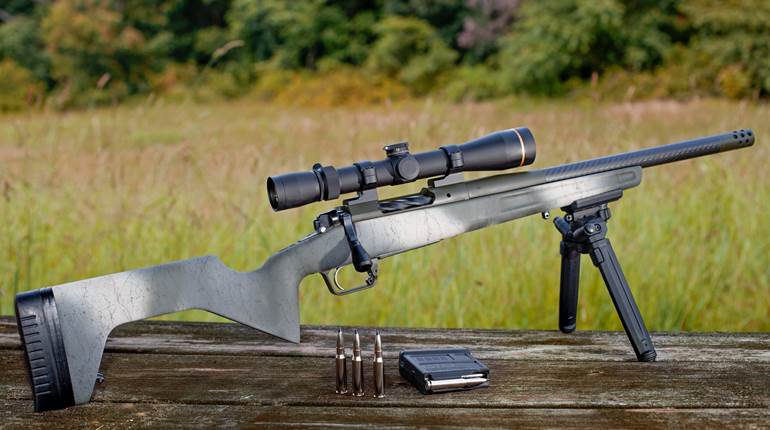
J.P. Sauer and Sohn is a German-based company best known for producing guns with finely figured walnut and polished steel. However, in following the current market trend of budget-driven bolt-action rifles, one of Germany’s oldest gunmakers has delivered a detachable-box-magazine-fed rifle with a polymer stock to American consumers—the Sauer 100 Classic XT.
Three action lengths are available for the Sauer 100 line of rifles—mini, medium and magnum. Our test rifle for this review, chambered for the .270 Win. cartridge, utilizes the medium-length receiver. The medium receiver can also accommodate several other cartridges: .243 Win., 6.5 mm Creedmoor, .308 Win., .30-’06 Sprg., 6.5x55 mm (Swedish), 8x57 mm Mauser (IS) and 9.3x62 mm. The mini-length receiver is reserved for .222 Rem. and .223 Rem., and the magnum for 7 mm Rem. Mag. and .300 Win. Mag.

A 22", sporter-contour, cold-hammer-forged barrel is press-fit to the rifle’s round receiver, a method that differs from the typical threading process seen on most bolt-action rifles. The muzzle is not threaded and features a target-style crown. Like many popular rifles today, the Sauer 100 Classic XT has a polymer stock with a detachable box magazine. A one-piece, full-diameter bolt with three lugs locks within the barrel extension. The bolt release on the receiver’s left side engages a raceway machined into the bolt to provide stability and guidance during travel. At the face of the bolt are two plunger-style ejectors and a sliding-plate extractor, while a red cocking indicator protrudes from the bolt’s rear. The bolt handle is capped with a round, polymer knob that bears lateral grooves in order to enhance purchase.
The company’s black Ergo Max polymer stock blends the styling of classic American and European designs. The fore-end shows its German heritage with a schnabel-style tip, and the grip area is a nod toward American appeal with a classic, near-straight wrist and an open-radius grip sweeping downward with a slight flare at the end near its grip cap. There is minimal palm swell on each side of the grip, despite the right-hand-driven bolt. Swoosh-shaped texturing is provided within the bilateral panels at the gun’s grip and fore-end. American-pattern sling swivel studs are installed fore and aft.
Upon examining the rifle’s marriage of barreled action to stock, we found a unique, piggy-backed fastener system. A 10-mm, six-point nut provides an attachment point for the forward-most bottom metal fastener. Once removed, users can separate the barreled action from the stock. The fit of the stock is snug to the receiver, and separating them may require light tapping. Many polymer-stocked bolt-action rifles incorporate an internal chassis that connects with a recoil lug affixed to the receiver or barrel; on the Sauer 100, the company employs a receiver recess to which a bedded, aluminum pillar block is mated. In addition to supporting the receiver, the pillar block supports the first 1/2" of the barrel—the rest of the barrel floats freely within the stock. The tang is supported by a series of glued and stacked metal washers—the assembly is likely adjustable at the factory, and used to improve fit.

Cartridges are held in the rifle by a flush-fitting, five-round, staggered-feed magazine that can be topped off during use. The action is of push-feed design. Dual feed ramps inside the barrel extension help guide cartridges to the chamber. Removal of the magazine requires depressing a spring-loaded button located forward of the magazine well within a circular recess in the bottom metal. There is a three-position safety on the right rear of the receiver. One reviewer felt that the force required to disengage the safety was lighter than preferred, but also mentioned that the bolt throw of the Sauer was fast and exceptionally smooth.

The rifle’s receiver is drilled and tapped to accept Remington Model 700-pattern bases, so users should have no trouble finding optic mounts for the Sauer 100 Classic XT. For our testing, we installed a Minox ZX5 5-25X 56 mm riflescope. Range testing followed our standard protocol of firing five consecutive, five-shot groups. Groups were consistent, with incremental growth noted throughout the shot string as the barrel heated. Testing proved the rifle to be a capable contender within its class. The average extreme spread measured 0.81", and Nosler’s 140-gr. Ballistic Tip ammunition provided the best five-group average (0.72"). All cartridges fired, chambered and extracted without fail. One tester noted the 14¼" length of pull was too long to comfortably reach for the bolt when shooting from the bench. The combination of stock design and rubber recoil pad provided sufficient recoil mitigation.
A sub-m.o.a., German-made rifle with utilitarian features and an MSRP of less than $800, the Sauer 100 Classic XT offers fine design and performance for its price point.







































